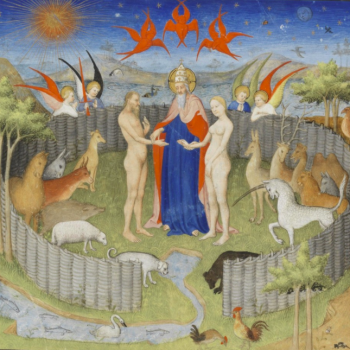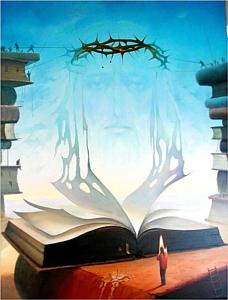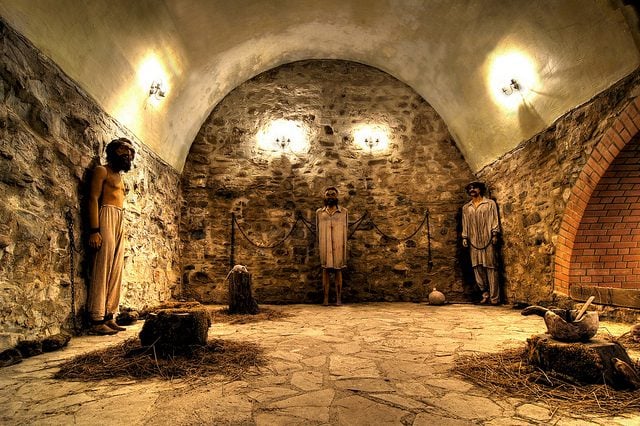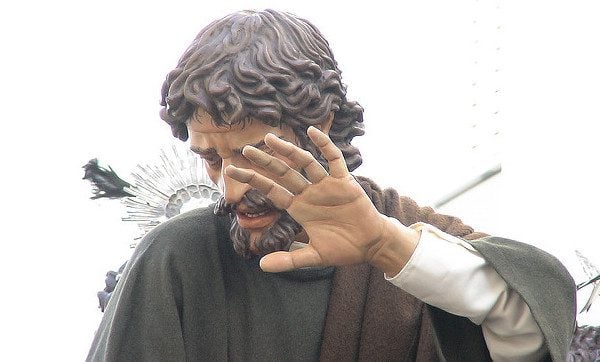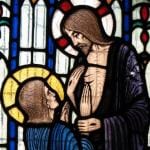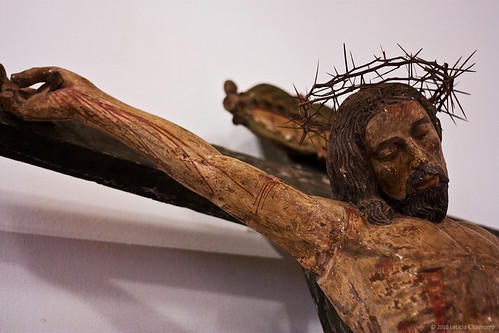
During Holy Week, we are tossed to and fro with stories of triumph and hosannas, last suppers, grieving prayers, betrayals, denials and crucifixion, all which lead to Easter and alleluias. Holy Week reminds me a little of the opening lines of Charles Dickens’ A Tale of Two Cities. “It was the best of times. It was the worst of times. It was the age of wisdom. It was the age of foolishness.”
In many ways, the story of the passion and crucifixion of our Lord in John’s gospel tonight is tale of two cities, two kingdoms really. One, the kingdoms of humankind, which come to power through violence and maintain it through oppression and the sword. The other, the kingdom of God, which comes to power through love and sacrifice and a towel.
John picks up this dynamic interplay between these two kingdoms throughout his story, beginning with Maundy Thursday, when Jesus, dressed in a towel, washes his disciples’ feet, dries them with the same towel and gives them a new command to love one another as he has loved them. He explains this new love further in his discourse, saying that there is no greater love than the one who lays down his life for his friends.
Surely, this love is on Peter’s mind the following evening in the garden when an army of Roman soldiers show up to arrest his Lord. Because tonight, in the garden, instead dressing in a towel as Jesus had, Peter brandishes a sword to demonstrate his love.
It is a bold, if impulsive, move. It wasn’t just a few soldiers and a handful of policemen that Peter confronts. This was an army — 600 Roman soldiers, 600 warriors whose swords and ferocity had built one of the greatest empires in the history of the world, 600 armed soldiers whose primary function as an occupying force was to pacify by violence any hint of rebellion in Judea.In the face of this army, Peter cuts off a servant’s ear with his sword, and drawing first blood, he sets the stage for battle.
No greater love has a man than to lay down his life for his friends.
This is what Peter believes himself to be doing: laying down his life for his friend and Lord Jesus the only way he knows how — with sword and violence.
And who can blame him? He does what any of us might when our closest friends and loved ones are threatened. He stands his ground. He lashes out. He strikes first. He won’t be going down without a fight.
It isn’t hard to imagine what might have happened next. The outraged gasps rippling through the ranks of 600 soldiers, the high-pitched metallic whine of 600 swords being drawn, shields and spears being readied. There is a tense moment before a confrontation like this escalates into an all-out battle. We’ve witnessed this scene a hundred times in movies and in our history, of the shot heard ‘round the world that sets wars and the human tinderbox of violence and retribution aflame.
It is a moment poised on the precipice of humanity’s propensity to answer threats and injustice with violence.
No greater love has a man than he who lays down his life for his friends.
Peter is ready to lay down his life, to take on the 600 swords of the soldiers with the one sword of a fisherman. It strikes me perhaps that Peter didn’t understand the kind of love Jesus embodied when he washed his disciples feet. Perhaps Peter didn’t realize exactly who Jesus considered his friends, exactly who Jesus was laying down his life for.
When Jesus accepts his arrest and eventually lays down his life on the cross, he isn’t just laying down his life for his friends as we would understand it, his disciples who had followed him, forsaking family, livelihoods and futures for him.
For Jesus friendship wasn’t so exclusive.
Rather, Jesus was laying down his life also for the soldiers who had come to arrest him as well. He was laying down his life for Judas, too. For Pilate, for Herod, as well as for Peter, John and the rest of the disciples In the gospel of John, Jesus lays down his life for the whole world — the whole world caught up in the unending cycle of violence. He lays down his life so that friend and foe can become one.
Jesus interrupts the violence Peter initiates. He not only tells his disciple to put away the sword, but in Luke’s gospel, he also heals the violence and bloodshed that Peter has done on his behalf. He restores the servant Malchus’ ear. Rather than joining the violent charge begun by Peter, rather than fighting, rather than striking back, Jesus instead makes his enemy whole.
In the garden, Jesus transforms Peter’s sword into a ploughshare. He shows us that kingdom of God does not come through violence, through bloodshed, but through blessed peacemakers, those that love and heal even their enemies.
This is the God that Jesus incarnates. This is the message of the passion and the crucifixion in John’s gospel. It is a story about how the upside-down kingdom of God comes, the kingdom in which the first is the last and the last first, in which the hungry, the meek and sorrowful are blessed. The kingdom of God comes not through swords and violence and armies as the kingdoms of the world come. It comes not through terror and oppression and miscarriages of justice that keep the wealthy and the powerful secure at the expense of everything else. It comes not through fear.
Instead, the kingdom of God comes through love, a love in which people lay down their lives for others.
It is not a kingdom we understand easily. Before Pilate, Jesus is asked about his kingdom. Jesus explains that his kingdom doesn’t follow the wisdom and logic of the world, because if it did, his followers would be fighting to the death for his release. If his kingdom had been of this world, he would have drawn a sword with Peter. If his kingdom operated according to the way of the world, there would be violence erupting in the Jerusalem in retaliation for his arrest.
But there is no retaliation and no retribution in the kingdom of God.
John’s gospel highlights this dichotomy between the kingdom of God and the kingdoms of the world even further when the people gathered are given a choice to free Jesus or to free Barabbas. Jesus, the Son of the Father, who refuses to fight or Barabbas, whose name literally means Son of the Father and is identified as a bandit — a word that in the Greek means he was a violent revolutionary who wanted to overthrow Rome’s occupation. So here, presented before us in the gospel, are two people, both proclaiming to be the Son of the Father. One represents the way of violence and war, the other the way of love and peace.
The people choose to save from the cross the way of war and violence. They choose to crucify love.
Too often, we make the same choice. Too often, we choose the sword, just like the people gathered who clamored for the release of Barabbas over Jesus. Too often, we believe that the world cannot be transformed by the towel and the washing of feet but only through the sword and violence.
So attached are we to the concept that might makes right, that injustice demands retaliation and retribution, that when faced with an alternative — the way of Jesus — we demand it be killed, crucified rather than face it.
The kingdom of God Jesus proclaimed seemed like such a disappointment! The Savior was not supposed to fold. The Savior was supposed to reign, to overthrow the oppressor, to establish by military might the kingdom of God’s people. That was the wisdom of the day. When the people cheered with palms and hosannas Jesus entrance into Jerusalem on a donkey, they thought they were welcoming the conqueror who would free them from the Roman oppressors, not one who would willingly go to crucifixion at the hands of the Romans.
But in the cross, Jesus proclaims something jarringly radical. In the crucifixion, he shows us that God can be wounded, that God suffers. It tells us that humanity’s propensity toward violence and retribution, revenge and bloodshed wounds even God. Unfortunately, we have tended to reverse this with the crucifixion, imagining instead that it is God who demanded blood and death on the cross. Nothing could be further from the truth, however.
It is we the people who demanded it.
And Jesus hanging on the cross — the death of the Incarnation of God — reveals to us in the harshest of terms exactly what it looks like when we embrace the violent wisdom of the world instead of the kingdom of God. Ultimately, the cross is a rejection of the violence of the world. It undermines it by revealing glaring ugliness of the wisdom of getting even and by telling us that only a suffering and wounded God can save a world as violent and wounded as ours. The crucifixion forces us to confront the upsetting, irrational and hopeful claim that the kingdom of God comes not through swords, war horses, retribution and the politically powerful. It comes instead through towels, donkeys, crucifixion and the least of these.
Now, I would like to stand up here tonight and tell you that crucifixion is a thing of a past. That the brutality and tragedy and violence represented by the crucifixion was exterminated completely by Jesus’s execution on the cross.
But as much as I would like to suggest such a thing, you and I both know I would be lying.
Everything that happened on the cross happens today. The innocent are still convicted and killed by the state — ours and around the world. Torture and terror, in the name of state and security, still occur throughout the world. Brutality happens. We are still a world that spins on the axis of violence and retribution, getting even and settling scores.
Jesus crucifixion doesn’t end the little crucifixions that continue in our world today just as his suffering doesn’t end the suffering we all experience. What Jesus’ crucifixion does however is identify God as standing in solidarity with us in our suffering and with those experiencing their own crucifixions. More to the point, the crucifixion makes it impossible for Christians to follow our Lord without looking at the suffering of the world and seeing the cross — Christ — in the midst of it all. It makes it impossible to turn a blind eye. In this crucifixion, God in Christ becomes one with the least of these and all those that have been beaten, been oppressed, been victimized at the hands of the powerful and the wisdom of violence.
In the end on Good Friday, we are left with choices, a tale of two kingdoms, God’s and the world’s. To which kingdom do we pledge our allegiance?
It is tempting to look at the cross as futile and as the triumph of evil, however temporary, over good, and as a result deny our discipleship as Peter did. It is tempting to deny our Lord as Peter did so we can remain comfortable, standing around the warmth of a charcoal fire. Because if Peter follows Jesus, he too might have been asked to take up a cross.
It is tempting to betray our Lord as Judas did, for sometimes the crucifixion seems like such weakness, like such foolishness. It is tempting when we confronted with the scandal of a crucified Lord to then fashion the crucifixion in our own violent image, as an act that prevents a bloodthirsty God from punishing his beloved people and sending them into darkness and torment. It is much harder to look at the cross as the path we must follow — the path that rejects violence, retaliation and “getting even” of any kind as an answer.
It is less tempting perhaps to go to the cross and face the crucifixion as the beloved disciple does. And at the cross, through Jesus, we find ourselves among a new family — our new brothers, new sisters, our new mothers and new fathers amid the suffering and the oppressed. We can look upon the crucified Lord together and hear him say, “Behold, your mother, grieving and sorrowful. Behold, your son, the incarcerated teenager on death row. Behold, your brother in the man tortured in the name of a nation. Behold, your sister in the hungry and disenfranchised.”
Behold the family of God at the foot of the cross.
Behold the kingdom of God is at hand.
Behold the cross.
(Veneration of the cross follows immediately)
____
Other Holy Week essays :
the Rev. Andrew Downs: What I Buy About the Cross
Sarah Moon: Crucifixion and Liberation
Opening to the Complexity: Holy Week Meditations (Five-part series beginning with Maundy Thursday)
Unforgiving Jesus on the Cross
The Death of God: (Three Part Series)
Sources:



